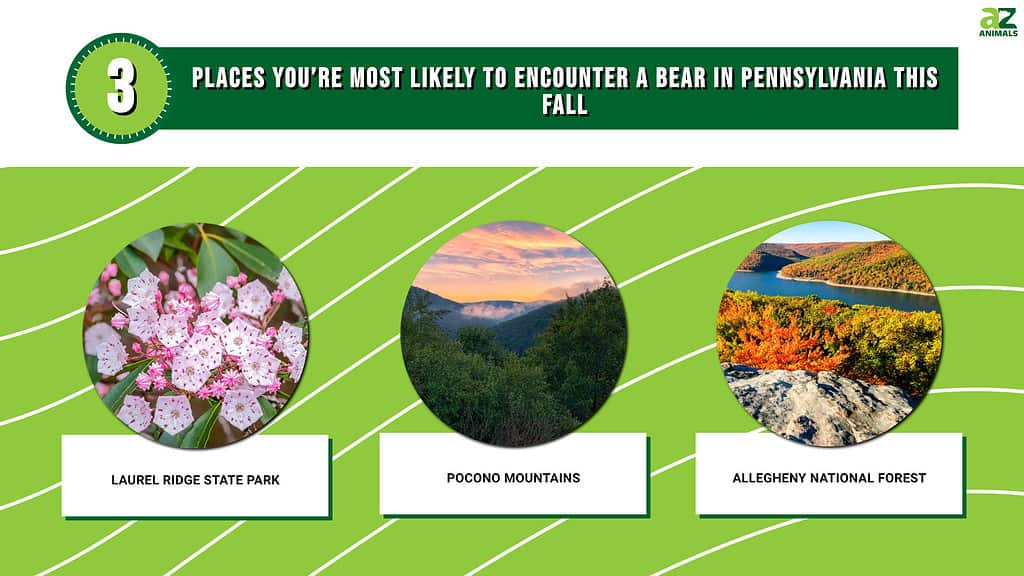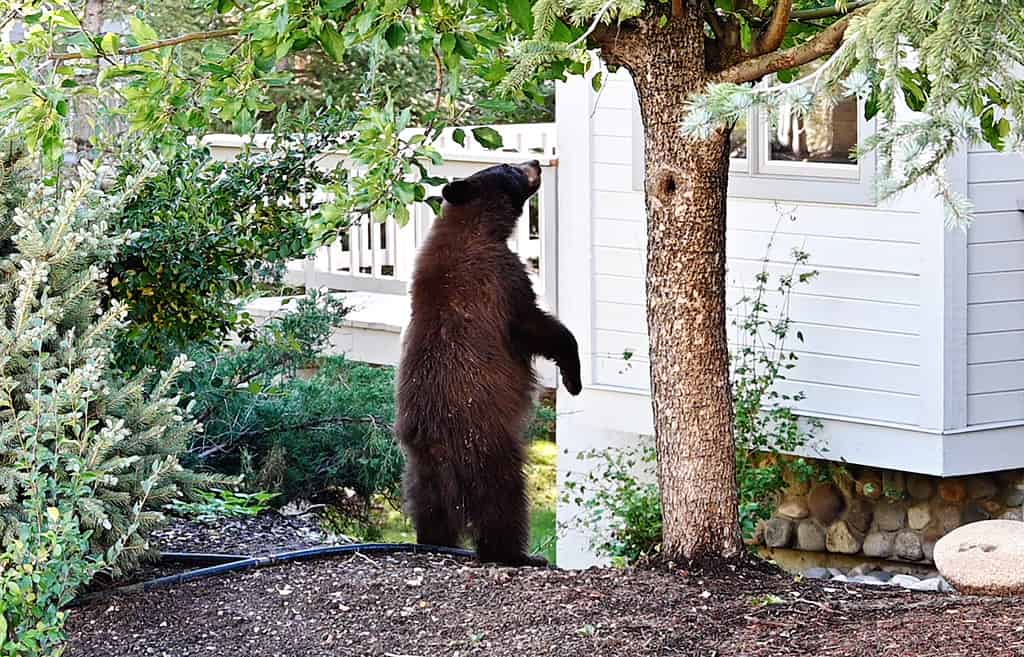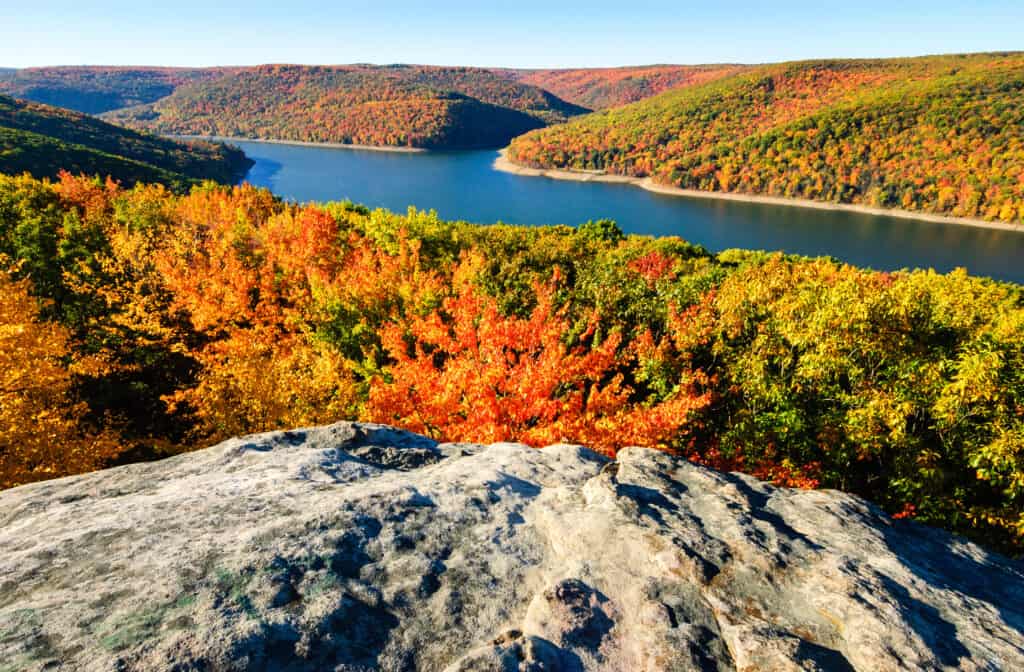The bear is one of the most iconic large mammals in North America. Three species of bears live in North America: the North American black bear, the brown bear, and the polar bear. Almost every part of the continent is home to at least one of these bears. Here are three places where you can find bears in Pennsylvania.

Are there bears in Pennsylvania?
Yes, there are bears in Pennsylvania. Although three types of bears live in North America, the only type of bear in Pennsylvania is the North American black bear. More than 16,000 black bears live in Pennsylvania. There have been bear sightings in every Pennsylvania county, but not every county has a thriving population of bears. Some counties do not have suitable habitats for bears, so bears seen there were just passing through. Most bears in Pennsylvania live in the northern and western parts of the state. The fewest bears live in the southeast corner of Pennsylvania, especially near the city of Philadelphia, because bears do not like to live near human development. Bears are more active in the fall when they are preparing for hibernation, so that’s when you’re most likely to see them outside of their usual range.
What to do if you see a bear in Pennsylvania

Black bears may visit houses or yards in search of food.
©steverts/iStock via Getty Images
The Pennsylvania Game Commission has specific advice to help Pennsylvania residents coexist with bears.
Bears in your yard
If you live in bear country, the most important way to avoid conflict with bears is to avoid providing them with food on your property. It is illegal in Pennsylvania to intentionally feed bears, as this poses a safety risk to both bears and humans. Your yard may provide bears with unintentional food sources such as trash, grill grease, bird feeders, compost, pet food, or fallen fruit from backyard trees. Remove these food sources or keep them in secure places. To prevent dogs from getting in a fight with a bear, keep them indoors or in a secure pen, and always keep them on leashes when out walking.
If you see a bear in your yard, you have two options. First, you can try to scare the bear away by making loud noises from a safe distance. Second, you can wait until the bear goes away. Afterward, clean up any mess the bear made and try to remove whatever attracted the bear.
Bears in the woods
Do not approach any bears you see while camping or hiking. To avoid luring bears close to you, keep your campsite clean and store all food in a secure place away from your sleeping tent. Do not leave trash behind at your campsite or in the woods. When hiking in places or at times with low visibility, make lots of noise while walking to avoid surprising a bear.
If you encounter a bear in the woods, make noise to alert the bear of your presence. This can be done by yelling, banging on metal, or honking a car horn. Most bears are afraid of humans and will leave if alerted. If the bear does not leave, slowly back away. Do not run or climb a tree. Running may trigger a chase response, while climbing a tree could be perceived as a threat since bears themselves, especially cubs, often climb trees to escape danger. Black bears rarely attack humans, but if one does attack you, fight back with a rock, stick, or any other weapon you can find. Even if you cannot do much damage, many bears will back off if you put up a fight. By taking proper precautions, you can enjoy observing bears from a distance without putting either of you in danger.
Laurel Ridge State Park

Pennsylvania’s state flower, the mountain laurel, is abundant in Laurel Ridge State Park and gives it its name.
©JayL/Shutterstock.com
Laurel Ridge State Park is a 13,625-acre park located along Laurel Mountain in southwestern Pennsylvania. This large park spans four Pennsylvania counties: Cambria, Fayette, Somerset, and Westmoreland. The main feature of Laurel Ridge State Park is the Laurel Highlands Hiking Trail. This 70-mile trail can be used for hiking or backpacking. A big part of the appeal of visiting Laurel Ridge State Park is its scenery. The park boasts wildflowers and lush greenery in the spring and summer, colorful foliage in the fall, and snow-covered landscapes in the winter. It is also a good place for wildlife watching, being home to frogs, toads, salamanders, box turtles, a wide variety of birds, white-tailed deer, and, of course, black bears.
Bears roam freely throughout Laurel Ridge State Park. Most of these bears are afraid of humans and tend to avoid them. However, they can get aggressive if humans get in the way of their food or approach their cubs. There have been no attacks or other incidents involving bears in this park in recent years. Therefore, you should be safe to explore the park as long as you keep your distance from bears and follow the safety guidelines.
Pocono Mountains

The Pocono Mountains are heavily wooded, providing good habitat for bears.
©iStock.com/quinntheislander
The Pocono Mountains cover 2,000 square miles in northeastern Pennsylvania. The area is heavily wooded and contains numerous lakes. The Poconos are a popular tourist destination, offering campgrounds, hiking trails, ski resorts, train tours, water parks, and many other outdoor activities. They are also home to lots of wildlife. In addition to black bears, there are squirrels, deer, raccoons, foxes, newts, toads, and a wide variety of birds including bald eagles.
The Poconos are home to a large concentration of Pennsylvania’s black bear population. Some of these bears, especially those living near campgrounds or residential areas, have become accustomed to human presence. This can cause problems when these bears decide to scavenge for human food. In September 2023, a man was clawed by a bear in the Poconos as he tried to herd the animal away from a cookout. The man was not seriously hurt, and the bear was spared because the attack was provoked and because there were no DNA samples with which to track the bear. In the past, however, there have been more serious or repeated attacks that led to the bear being killed. That is why avoiding feeding bears is an important matter of safety for humans and bears alike.
Allegheny National Forest

The Allegheny National Forest has great views with brilliant colors in the fall.
©Zack Frank/Shutterstock.com
The Allegheny National Forest is a 514,029-acre forest located on the Allegheny Plateau in northwestern Pennsylvania. It offers outdoor recreation including biking, camping, hiking, canoeing and kayaking, and Off-Highway Vehicle (OHV) riding. It is also an important home for wildlife, including 50 species of mammals, 200 species of birds, 25 species of amphibians, 20 species of reptiles, 80 species of fishes, and 25 species of freshwater mussels. Some of these species include black bears, white-tailed deer, gray foxes, wild turkeys, squirrels, chipmunks, red-backed salamanders, wood frogs, beavers, raccoons, ruffed grouse, rattlesnakes, snowshoe hares, river otters, bald eagles, ospreys, hawks, owls, warblers, finches, orioles, swallows, thrushes, sparrows, chickadees, and hummingbirds.
The Allegheny National Forest has a thriving population of black bears. It is possible to observe these bears from a safe distance while hiking the forest’s trails or driving on its scenic roads. In 2022, there were numerous reports of bears at campsites in the Allegheny National Forest. Therefore, if you camp in the area, be sure to follow safety guidelines. Bears can be dangerous, but they can also be fascinating creatures to observe in nature.
The photo featured at the top of this post is © Menno Schaefer/Shutterstock.com
Thank you for reading! Have some feedback for us? Contact the AZ Animals editorial team.






